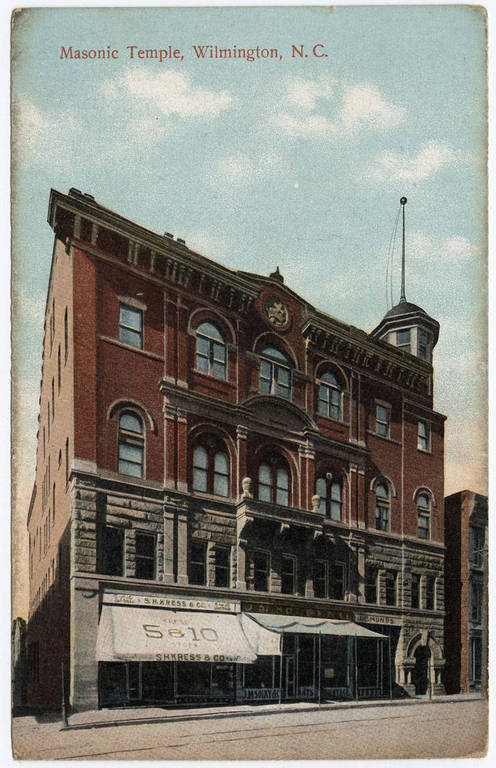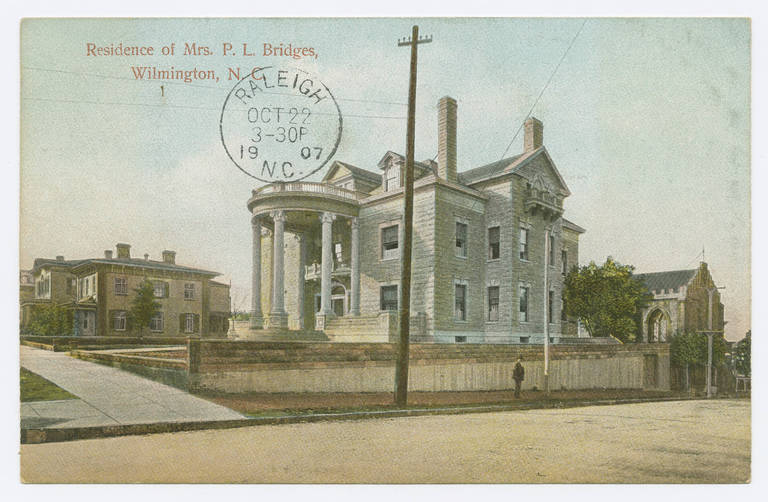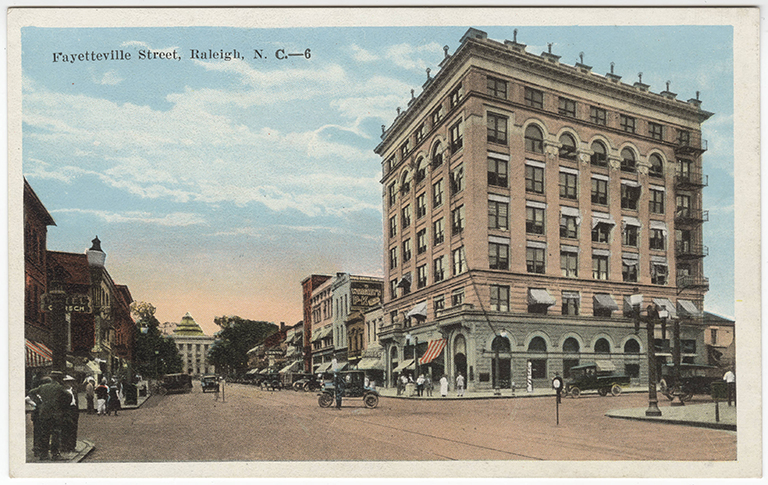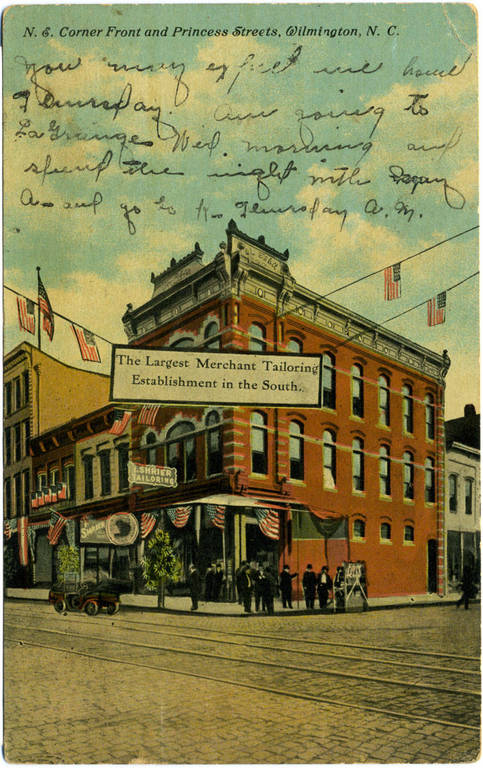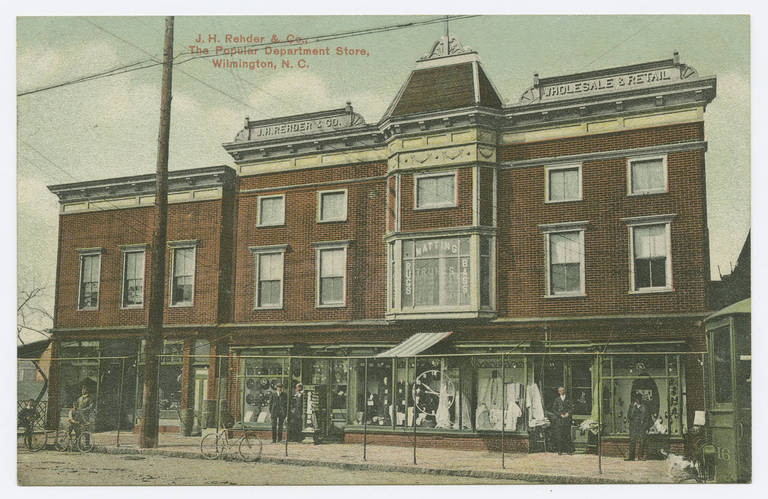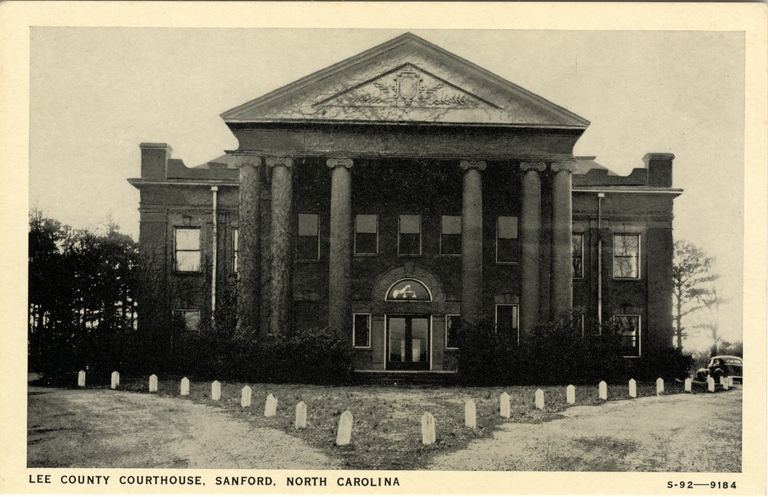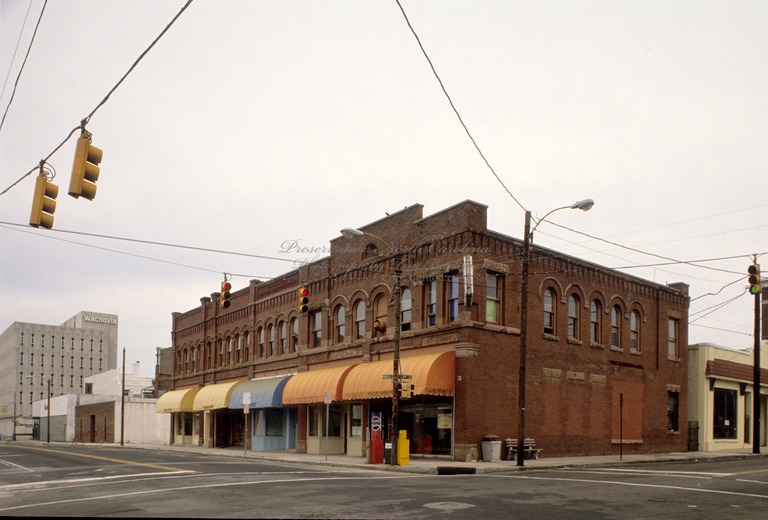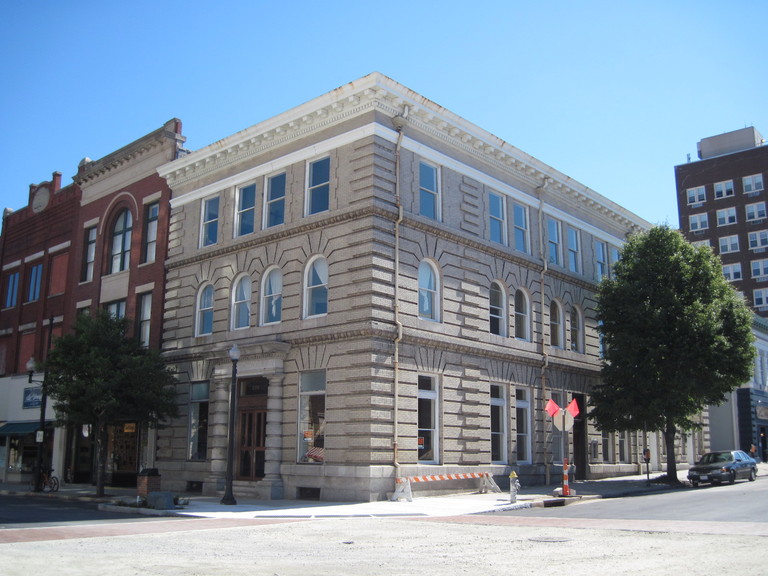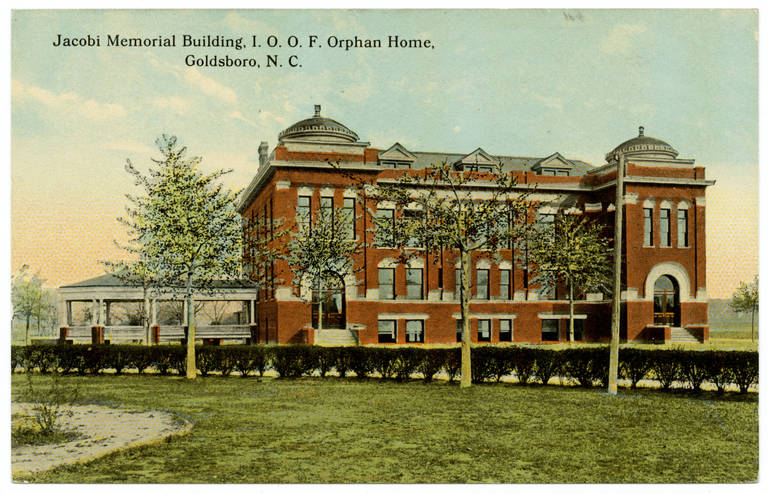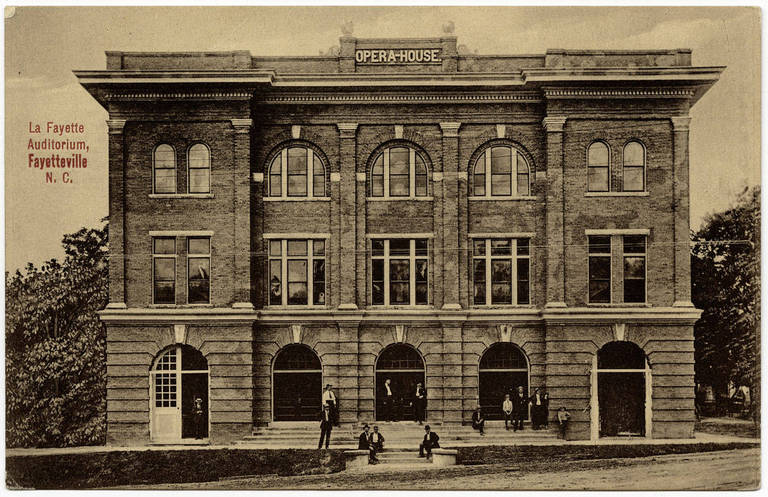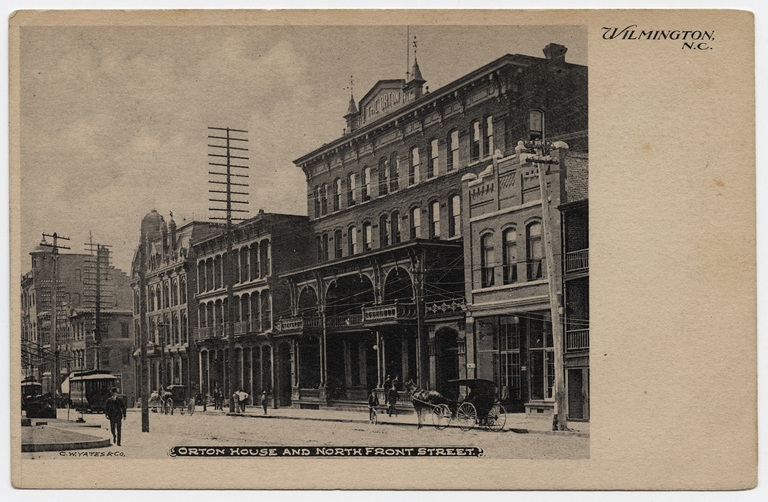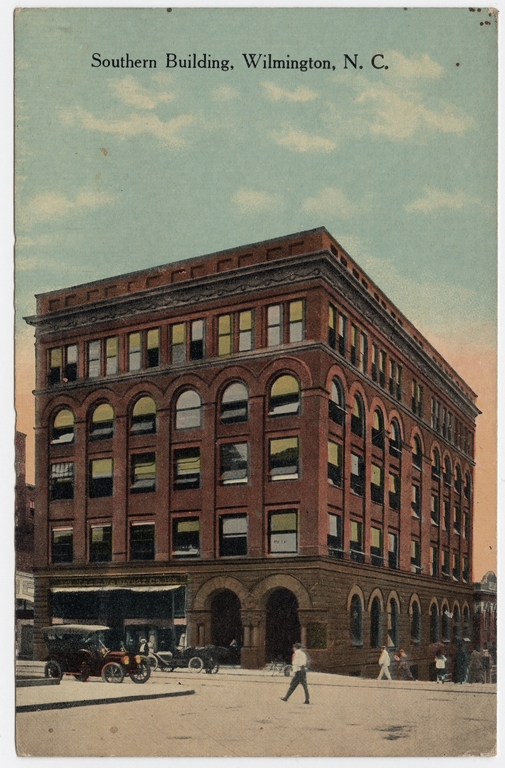McMillen, Charles (1854-1911)
Birthplace:
Ireland
Residences:
- Oklahoma City, Oklahoma
- Wilmington, North Carolina
- Duluth, Minnesota
Trades:
- Architect
Building Types:
Styles & Forms:
Neoclassical Revival; Queen Anne; Renaissance Revival; Romanesque Revival
Charles McMillen (1854-1911), an Irish-born architect, was one of many mobile architects who worked in cities across America in the late 19th and early 20th centuries. Active in Duluth in the 1880s and 1890s, he moved to Wilmington, North Carolina, after winning a competition to design the port city’s Masonic Temple in 1898. He quickly became a leading architect in town and designed several major buildings in Wilmington as well as the Grand Lodge Masonic Temple in Raleigh before moving in 1908 to Oklahoma, where he died in 1911.
McMillen’s early life, training, and accomplishments are unknown. According to United States census records, he was born in 1854 in Ireland, but when he came to the United States is not established. By 1885 he was working as an architect in Duluth and was married to Isabel, a native of New York, and they had two young children, Charles Jr., and Mary, both born in Minnesota. Isabel died by the early 1890s, and the widowed Charles married a young woman named Nell from Michigan. In Duluth, McMillen became an accomplished architect in a thriving and immensely wealthy industrial city known for its imposing architecture, including ornate Queen Anne residences and massive brick and stone Richardsonian Romanesque public and institutional buildings. McMillen’s best known building in Duluth (with architect E. S. Stebbins) was the city’s landmark Masonic Lodge of 1889, a towering 6-story stone edifice in ornate Romanesque Revival style.
How McMillen learned about the Masonic Temple project in Wilmington, North Carolina, has not been ascertained, but it is likely that the Wilmington Masons advertised for submissions in Masonic journals of the day. In 1898 McMillen submitted a proposal, and won the commission over local contenders James F. Post and Henry E. Bonitz.
McMillen met with a warm welcome in Wilmington. The Wilmington Star of January 6, 1899, reported that he and his wife and daughter had arrived from Duluth the previous day and were registered at the Orton Hotel. “Mr. McMillen is the architect who drafted the plans for and will superintend the construction of the magnificent new Masonic Temple soon to be erected on Front Street by the Masons of Wilmington.” Before the end of the year, the Wilmington Messenger reported on November 12, 1899, that McMillen’s design for the Masonic temple had “met with very generous approval. He is an architect of experience and marked ability. Fourteen Masonic Temples have been built in different cities by plans and specifications prepared by him. He has personally supervised, in a most acceptable manner, the erection of the Masonic Temple here.”
On the strength of this commission and encouraged by his contacts in Wilmington, McMillen settled in the southern port city, where in 1900 McMillen, 45, and his wife Nell and their children were living on Red Cross Street. McMillen hit Wilmington at a propitious time for a new architect familiar with urban models, and his work and probably his personality suited the local leadership. With the Masonic project McMillen tapped into an important client group, for the Masons in Wilmington included both the old guard and the leading Jewish businessmen.
McMillen offered the city the cachet of urban experience and sophisticated design skills, as well as expertise in constructing large and complex buildings with modern technological features. Such qualities, including his mastery of the imposing Richardsonian Romanesque style as well as new neoclassical modes, doubtless recommended him to leading Wilmingtonians. In Duluth, McMillen had been one of many architects competent to execute urban models, but in Wilmington his experience and skills enabled him to become something of a “big frog in a little pond.”
Even before the Masonic Building began to rise, McMillen attracted a commission for the Messenger and Southern Bell Telephone and Telegraph Building (1899) in red pressed brick with brownstone trim, and within a few years, he designed imposing downtown buildings on premier locations. A 1908 promotional booklet highlighted new downtown buildings, including McMillen’s Murchison National Bank (1902), the boldly executed Romanesque Revival Southern Building (1905), and the I.M. Bear Building (1906). Indicative of McMillen’s appeal to the local establishment, when the Carolina Yacht Club at Wrightsville Beach near Wilmington was destroyed by a hurricane in 1899, the members had him plan its successor along similar lines, and the elite Cape Fear Club asked him to remodel their venerable club house in 1902. Leading Wilmingtonians also employed him to design or remodel their residences. He transformed an antebellum Italianate house into a Queen Anne residence for Congressman John D. Bellamy, Jr. (Wright-Harriss-Bellamy House), and planned a neoclassical mansion in locally unusual Indiana limestone for the railroad empire widow Elizabeth Eagles Haywood Bridgers in 1905 (Bridgers House).
Soon after arriving in Wilmington, McMillen began efforts to organize the profession and connect with other architects. In 1900, the Wilmington Star reported on December 29 that McMillen had been elected vice president of the Southeastern Architectural League, newly formed in Charlotte. He was instrumental in founding the organization, which had as its president Richard Sharp Smith of Asheville. Wilmington architect Henry Bonitz was a member of the executive committee, and there were also members from Greensboro and Raleigh. The league preceded by several years the North Carolina Architectural Association (1906) and the North Carolina Chapter of the American Institute of Architects (1913). Early in 1901, McMillen responded to a “circular letter” he had received from Glenn Brown, secretary of the national American Institute of Architects, encouraging non-member architects to join the AIA. McMillen wrote to Brown on April 28, 1901, that he was eager to join and he wished he had done so earlier because he had practiced as an architect in the northwest since 1883. He noted that he and others had recently organized the Architectural League for architects in North and South Carolina. He asked if he could join the AIA based on endorsements from members of the Minnesota chapter of the AIA. But because he did not know personally the requisite three AIA national members who could endorse him, he (like other architects outside of major cities) did not meet the standard for membership. He continued his interest in professional organizations, however, and the Wilmington Star reported on July 14, 1907 his election to the board of directors of the North Carolina Architectural Association—predecessor to the state chapter of the American Institute of Architects.
McMillen’s specialty in Masonic and other fraternal buildings led to commissions beyond Wilmington. In Goldsboro, he planned a large, classically detailed building for the state Odd Fellows Home orphanage, the Nathaniel Jacobi Memorial Building, named for a Wilmington benefactor. When the Grand Lodge of Masons in Raleigh decided to erect a skyscraper office and temple on a prime site on Fayetteville Street, they commissioned McMillen to plan the “magnificent” and classically detailed 7-story “skyscraper”—one of the state’s first two steel-reinforced tall buildings along with William Lee Stoddart’s Independence Building in Charlotte. In Wilmington, McMillen employed young architects as draftsmen, including Harry P. S. Keller, and in 1907, with many projects on hand, he announced in the Wilmington Star (June 9, 1907) his new partnership with architect Carl B. Cooper as McMillen and Cooper.
For reasons yet unknown, in 1908, after a remarkably successful decade in North Carolina, McMillen made yet another move, back to the western part of the country. The census of 1910 listed him as an architect in Oklahoma City with his wife Nell and his children. But soon after this, the Wilmington Star of August 8, 1911, reported, “Mr. Charles M’Millen Dead - Former Wilmingtonian Dies in Oklahoma City.” The cause was heart failure. The newspaper announced that his burial would take place at Oakdale Cemetery after a funeral with Masonic honors, and commented, “Mr. McMillen was one of the most prominent architects in this section at the time he left Wilmington. The local Masonic Temple, the Sprunt Building, and the Bellamy home were all designed by him, and stand as monuments to his ability in his chosen line of work. He had hundreds of friends here who will be pained to learn of his untimely death.” During his short tenure in Wilmington, McMillen brought his skills with large-scale and elaborate architecture to a community eager for statements of urbanity and prosperity, and he produced some of its most imposing edifices of the turn of the century.
- Catherine W. Bishir, Michael T. Southern, and Jennifer F. Martin, A Guide to the Historic Architecture of Western North Carolina (1999).
- Susan Taylor Block, Cape Fear Lost (1999).
- Jane Hall, “Founding Fathers NCAIA, 1913-1954,” Southern Architect (1954), reproduced in C. David Jackson and Charlotte V. Brown, History of the North Carolina Chapter of the American Institute of Architects, 1913-1998 (1998).
- Charles McMillen to Glenn Brown, Apr. 28, 1901 (RG 803 Box 8, folder 11) and May 17, 1905 (RG 803, Box 9, Folder 90, American Institute of Architects Archives, Washington, D.C., copy in Charles McMillen file, Charlotte Vestal Brown Papers, Special Collections Research Center, North Carolina State University Libraries, Raleigh, North Carolina.
- Minnesota Census, 1885.
- Maryanne C. Norton and Sheldon T. Aubut, Duluth, Minnesota, Images of America (2001).
- William Reaves Files, notes from Wilmington newspapers, copy in Charles McMillen file, Charlotte Vestal Brown Papers, Special Collections Research Center, North Carolina State University Libraries, Raleigh, North Carolina.
- Beverly Tetterton, Wilmington: Lost But Not Forgotten (2005).
- United States Census, 1880; 1900-1910.
- Tony P. Wrenn, Wilmington, North Carolina: An Architectural and Historical Portrait (1984).
Abram David House
Contributors:Charles McMillen, attributed architectDates:1902
Location:Wilmington, New Hanover CountyStreet Address:617 Market St., Wilmington, NC
Status:No longer standing
Type:Residential
Images Published In:Susan Taylor Block, Cape Fear Lost (1999).
Note:According to Susan Taylor Block, Cape Fear Lost (1999), in 1902 Abram David moved from his house at 619 Market St. to this new house at 617 Market St, designed by McMillen.
Airlie
Contributors:Charles McMillen, architect; C.T. Shepard, contractorDates:1901
Location:Wrightsville Sound, New Hanover CountyStreet Address:300 Airlie Rd., Wrightsville Sound, NC
Status:No longer standing
Type:Residential
Images Published In:Susan Taylor Block, Cape Fear Lost (1999).
Note:Pembroke Jones awarded a contract to C. T. Shepard to construct a buidling for use as a tennis court, ballroom and hall for private theatricals. Plans were by Charles McMillen. It was to be 50 x 100 feet with arched ceiling 30 feet high in the center. “Polished hardwood floor will make an excellent place for dancing. Seats will run all the way around the walls for the benefit of spectators of the tennis, dancing and private theatricals” (Wilmington Dispatch, January 9, 1901; Messenger, January 10, 1901).
Baptist Edifice
Contributors:Charles McMillen, architectDates:1908
Location:Lumberton, Robeson CountyStreet Address:Lumberton, NC
Status:Unknown
Type:Religious
Note:The Baptists in Lumberton had plans in hand by McMillen for an “edifice” (Manufacturers’ Record, Oct. 8, 1908).
Barbara Bear House
Contributors:Charles McMillen, attributed architectDates:1905
Location:Wilmington, New Hanover CountyStreet Address:SE corner of 5th St. and Chestnut St., Wilmington, NC
Status:No longer standing
Type:Residential
Note:The Wilmington Star of November 30 and December 2, 1905, noted that McMillen had drawn plans for a residence for Mrs. Barbara Bear. She was, according to Susan Taylor Block, the widow of Samuel Bear.
Bishop's Residence
Contributors:Charles McMillen, architectDates:1905-1908
Location:Wilmington, New Hanover CountyStreet Address:510-512 Orange St., Wilmington, NC
Status:Standing
Type:Residential
Images Published In:Tony P. Wrenn, Wilmington, North Carolina: An Architectural and Historical Portrait (1984).
Note:The Wilmington Messenger of June 8, 1907, stated that McMillen had designed the Bishop’s Residence. The imposing Colonial Revival residence with Ionic portico was erected by the Episcopal Diocese for the bishop of the diocese of Eastern North Carolina.
Boys' Brigade Armory
Contributors:Robert H. Brady, contractor; Charles McMillen, architectDates:1905
Location:Wilmington, New Hanover CountyStreet Address:SE corner of 2nd St. and Church St., Wilmington, NC
Status:No longer standing
Type:Recreational
Images Published In:Susan Taylor Block, Cape Fear Lost (1999).
Beverly Tetterton, Wilmington: Lost But Not Forgotten (2005).Note:McMillen planned the castellated stucture of stone-faced concrete blocks for the “Brigade” founded by local businessmen to serve underprivileged local white boys. It contained recreational facilities, an auditorium, and a dining hall.
Burgaw Graded School
Contributors:Charles McMillen, architectDates:1907
Location:Burgaw, Pender CountyStreet Address:Burgaw, NC
Status:Unknown
Type:Educational
Cape Fear Club
Contributors:F. A. Applegate, builder; Charles McMillen, architectDates:1902
Location:Wilmington, New Hanover CountyStreet Address:NW corner of Front St. and Chestnut St., Wilmington, NC
Status:No longer standing
Type:Recreational
Images Published In:Susan Taylor Block, Cape Fear Lost (1999).
Note:The Wilmington Messenger of February 9, 1902 reported, “Mr. F. A. Applegate has completed the Cape Fear club’s home on the northwest corner of Front and Chestnut streets according to the plans of Mr. Charles McMillen, the architect, who entirely remodeled the establishment.”
Cape Fear Lodge I. O. O. F. Temple
Contributors:Charles McMillen, architectVariant Name(s):Odd Fellows Building
Dates:1904
Location:Wilmington, New Hanover CountyStreet Address:3rd St., Wilmington, NC
Status:No longer standing
Type:Fraternal
Images Published In:Susan Taylor Block, Cape Fear Lost (1999).
Beverly Tetterton, Wilmington: Lost But Not Forgotten (2005).Note:The Cape Fear Lodge of the I. O. O. F. had “accepted plans” by McMillen for a temple to be 3 stories tall, 67 by 78 feet, and to cost $25,000” (Manufacturers’ Record, Feb. 25, 1904).
Carolina Yacht Club
Contributors:Charles McMillen, architect; Thad F. Tyler, builderDates:1900
Location:Wrightsville Beach, New Hanover CountyStreet Address:401 S Lumina Ave., Wrightsville Beach, NC
Status:No longer standing
Type:Recreational
Images Published In:Susan Taylor Block, Cape Fear Beaches (2000).
Beverly Tetterton, Wilmington: Lost But Not Forgotten (2005).Note:The shingled Yacht Club was built to replace the 1883 James F. Post designed predecessor destroyed in a hurricane of 1899, and it stood until it was destroyed by Hurricane Hazel in 1954. The 1955 replacement takes a similar form (Anne Russell, Carolina Yacht Club Chronicles [1993]).
Carolina Yacht Club Bath Houses
Contributors:Charles McMillen, architectDates:1902
Location:Wrightsville Beach, New Hanover CountyStreet Address:401 S Lumina Ave., Wrightsville Beach, NC
Status:No longer standing
Type:Recreational
Images Published In:Susan Taylor Block, Cape Fear Beaches (2000).
Central Fire House
Contributors:Charles McMillen, architectDates:1902
Location:Wilmington, New Hanover CountyStreet Address:16 S. 4th St., Wilmington, NC
Status:No longer standing
Type:Public
Delgado Methodist Church
Contributors:Charles McMillen, architectDates:1900
Location:Wilmington, New Hanover CountyStreet Address:Wilmington, NC
Status:Unbuilt
Type:Religious
Elizabeth Bridgers House
Contributors:Charles McMillen, architect; Joseph Schad, contractorVariant Name(s):Graystone
Dates:1905
Location:Wilmington, New Hanover CountyStreet Address:SW corner of 3rd St. and Dock St., Wilmington, NC
Status:Standing
Type:Residential
Images Published In:Tony P. Wrenn, Wilmington, North Carolina: An Architectural and Historical Portrait (1984).
Note:Built for Elizabeth Eagles Haywood Bridgers, widow of Preston Bridgers of the Wilmington and Weldon Railroad family, the massive stone house with towering portico is one of the city’s most opulent residences of its day. One of the few stone houses in town, it was built of Indiana limestone. Stonecutter foreman was J. H. Niggel of South Carolina, who remained in Wilmington and founded the Carolina Cut Stone Company. The stone, which has been identified as Indiana limestone, was dressed on site.
First Presbyterian Church Manse
Contributors:Charles McMillen, architect; C. B. West, contractorDates:1906
Location:Wilmington, New Hanover CountyStreet Address:Wilmington, NC
Status:No longer standing
Type:Residential
Images Published In:Susan Taylor Block, Cape Fear Lost (1999).
Note:Builder C. B. West of Greenville, N.C., took the contract to build a 2-story brick-veneered manse for First Presbyterian Church from plans by McMillen at a cost of $7,500 (Manufacturers’ Record, Mar. 8, 1906).
Grand Lodge Masonic Temple
Contributors:Central Carolina Construction Company, contractors; Coffey Family, superintendents; John W. Coffey, superintendent; Charles McMillen, architectDates:1907
Location:Raleigh, Wake CountyStreet Address:133 Fayetteville St., Raleigh, NC
Status:Standing
Type:Fraternal
Images Published In:Linda L. Harris and Mary Ann Lee, An Architectural and Historical Inventory of Raleigh, North Carolina (1978).
Note:Cited in the Manufacturers’ Record (April 18, 1907) as the “Grand Lodge of Masons Building,” the 7-story building like other Masonic buildings included rental space for stores and offices as well as the Masonic hall. Faced in tan brick and detailed in neoclassical fashion, the building is especially noteworthy as the state’s oldest reinforced steel tall building, having survived after the slightly earlier Independence Building in Charlotte (1906) has been lost. As noted in the Raleigh Times of August 5, 1909, John W. Coffey was superintendent of this building for the contractors, and a photograph in the Coffey Family Papers (Special Collections Research Center, NCSU Libraries) shows Coffey at the building site in the early phase of construction.
Hemenway School
Contributors:Charles McMillen, architect (1902); James F. Post, contractor (1889; 1897)Dates:1889; 1897 [expansion]; 1902 [addition]
Location:Wilmington, New Hanover CountyStreet Address:212 N. 5th St., Wilmington, NC
Status:No longer standing
Type:Educational
Note:The building was the successor to an earlier Hemenway School by Henry Taylor. The Wilmington Star of August 16, 1902, noted that McMillen had designed a south wing for the school.
I. M. Bear Building
Contributors:John H. Brunjes, builder; Charles McMillen, architectVariant Name(s):Efirds Department Stores Department Store; Einstein Building
Dates:1906-1907
Location:Wilmington, New Hanover CountyStreet Address:272 N. Front St., Wilmington, NC
Status:Standing
Type:Commercial
Images Published In:Beverly Tetterton, Wilmington: Lost But Not Forgotten (2005).
Note:In 1906, McMillen completed plans for a 5-story, pressed brick and terra cotta building constructed by J. H. Brunjes. The contract went to Newport News builders Howard and Moss. (Manufacturers’ Record, Sept. 6, 1906). According to Tony Wrenn, in Wilmington, North Carolina: An Architectural and Historical Portrait (1984), the Romanesque Revival building was constructed by Brunjes for tenants I. M. Bear and Company, merchants, and was known as the I. M. Bear Building. It was later the Einstein Building and still later became Efird’s Department Store
I. Shrier Store and Office
Contributors:W. E. Glen, contractor; Charles McMillen, architectDates:1905
Location:Wilmington, New Hanover CountyStreet Address:102 N. Front St., Wilmington, NC
Status:Standing
Type:Commercial
Note:W. E. Glen had a contract to build a 3-story, pressed brick store and office building for R. I. Shrier from McMillen’s plans (Manufacturers’ Record, Feb. 9, 1905). This may be Isaac Shrier, a clothier who according to Tony Wrenn, in Wilmington, North Carolina: An Architectural and Historical Portrait (1984), once had his shop at 26 Market St. The Wilmington Star reported on Nov. 27, 1904, “I. Shrier will erect a new building soon, 3 stories high, 36 feet on N. Front, back into the block 100 feet. The style of architecture will be Italian Renaissance, and the material will be a plain and moulded red press brick with brown stone trimmings.”
J. M. Solkey House
Contributors:Charles McMillen, architectDates:1905
Location:Wilmington, New Hanover CountyStreet Address:7th St. and Dock St., Wilmington, NC
Status:Unknown
Type:Residential
J.H. Rehder and Company Store
Contributors:Charles McMillen, architectDates:Ca. 1902
Location:Wilmington, New Hanover CountyStreet Address:617 N. 4th St., Wilmington, NC
Status:No longer standing
Type:Commercial
Images Published In:Susan Taylor Block, Cape Fear Lost (1999).
James Walker Memorial Hospital
Contributors:Charles McMillen, architect; James Walker, builderDates:1900-1901
Location:Wilmington, New Hanover CountyStreet Address:10th St. at Rankin St., Wilmington, NC
Status:No longer standing
Type:Health Care
Images Published In:Susan Taylor Block, Cape Fear Lost (1999).
Beverly Tetterton, Wilmington: Lost But Not Forgotten (2005).Note:The Wilmington Morning Star of February 28, 1900, and the Wilmington Weekly Star of March 2, 1900, identified Charles McMillen as the architect for the hospital. Builder Walker donated the building; he died before it was quite completed.
James Walker Memorial Hospital Colored Annex
Contributors:Howe Family, builders; Valentine Howe, builder; Charles McMillen, architectDates:1904
Location:Wilmington, New Hanover CountyStreet Address:10th St. at Rankin St., Wilmington, NC
Status:No longer standing
Type:Health Care
John A. Taylor House
Contributors:Benjamin Gardner, attributed builder (ca. 1846); Charles McMillen, architectVariant Name(s):Wilmington Light Infantry Armory
Dates:Ca. 1846; 1902
Location:Wilmington, New Hanover CountyStreet Address:411 Market St., Wilmington, NC
Status:Standing
Type:Residential
Images Published In:Catherine W. Bishir, North Carolina Architecture (1990).
Catherine W. Bishir and Michael T. Southern, A Guide to the Historic Architecture of Eastern North Carolina (1996).Note:The marble-fronted brick mansion of severe Greek Revival design is unique in the state. It is attributed to Gardner in later 19th century newspaper accounts (see Wilmington Dispatch of July 28, 1896). The Wilmington Star of July 2, 1902, noted that McMillen had designed “extensive and costly repairs” to the building.
John H. Rehder House
Contributors:Charles McMillen, architect; Rogers and Thomas, contractorsDates:1905
Location:Wilmington, New Hanover CountyStreet Address:801 Market St., Wilmington, NC
Status:No longer standing
Type:Residential
Images Published In:Susan Taylor Block, Cape Fear Lost (1999).
L. B. Pennington House
Contributors:Charles McMillen, architect; Rogers and Thomas, contractorsDates:1903
Location:Wilmington, New Hanover CountyStreet Address:610 Market St., Wilmington, NC
Status:Standing
Type:Residential
Lee County Courthouse
Contributors:Charles McMillen, architectDates:1908
Location:Sanford, Lee CountyStreet Address:Horner Blvd., Sanford, NC
Status:Standing
Type:Public
Images Published In:Catherine W. Bishir and Michael T. Southern, A Guide to the Historic Architecture of Piedmont North Carolina (2003).
Note:The building makes unusually extensive use of pressed brick, including the Ionic columns of the portico. The brick came from South Carolina. The brownstone of the column capitals and bases came from local quarries, from which a great deal of brownstone was shipped to other locales.
Masonic Temple
Contributors:David Getaz, contractor; David Getaz Company, contractors; Joseph F. Leitner, architect (1914); Charles McMillen, architect (1898-1899); Frederick B. Miles, sculptorDates:1898-1899; 1914 [remodeled]
Location:Wilmington, New Hanover CountyStreet Address:25 N. Front St., Wilmington, NC
Status:Standing
Type:Fraternal
Images Published In:Tony P. Wrenn, Wilmington, North Carolina: An Architectural and Historical Portrait (1984).
Note:Wilmington architect-builder James F. Post submitted an earlier design for the Masonic Temple, but the Masons chose the design by the Minnesota architect McMillen, who specialized in Masonic temples. This commission brought McMillen to Wilmington, where he settled down to practice his profession. The cornerstone was laid on May 18, 1899, and the building opened on November 20. The 4-story edifice of pressed brick and brownstone had stores on the first floor, offices on the second floor, the Masonic lodge halls on the third floor, and a ballroom on the fourth floor. Frederick B. Miles executed the carved ornament of the entrance. In January, 1914, the Scottish Rite Masons leased the ballroom from the central body and expended $4000 to create a theater, complete with stage, designed by Joseph F. Leitner. For more details, see Janet K. Seapker, “St. John’s Masonic Lodge, Part II: Other Masonic Lodges,” Lower Cape Fear Historical Society Bulletin, Vol. L, No. 2, April 2006; and Tony P. Wrenn, Wilmington, North Carolina: An Architectural and Historical Portrait (1984).
Messenger and Southern Bell Telephone and Telegraph Building
Contributors:Central Construction, builders; Charles McMillen, architect; L.H. Vollers, builderDates:1899-1906
Location:Wilmington, New Hanover CountyStreet Address:121-127 Princess St., Wilmington, NC
Status:Standing
Type:Commercial
Images Published In:Catherine W. Bishir, North Carolina Architecture (1990).
Tony P. Wrenn, Wilmington, North Carolina: An Architectural and Historical Portrait (1984).Note:The 2-story brick building in corbeled red brick developed in several stages. McMillen took the commission even before construction began on his “magnificent” Masonic building.
Morris Bear and Brothers Store
Contributors:Charles McMillen, architectDates:1906
Location:Wilmington, New Hanover CountyStreet Address:Wilmington, NC
Status:Unknown
Type:Commercial
Note:In 1906 McMillen drew plans for a store for “Morris Bear and Brother” (Manufacturers’ Record, Sept. 6, 1906).
Murchison National Bank
Contributors:Charles McMillen, architectVariant Name(s):Acme Building
Dates:1902
Location:Wilmington, New Hanover CountyStreet Address:200 N. Front St., Wilmington, NC
Status:Standing
Type:Commercial
Images Published In:Tony P. Wrenn, Wilmington, North Carolina: An Architectural and Historical Portrait (1984).
Note:The 3-story blond brick and stone bank was built for a New York/Wilmington firm owned by a Wilmington family. In the accompanying image, McMillen’s Murchison National Bank stands to the left of the post office.
Nathaniel Jacobi Memorial Building
Contributors:Charles McMillen, architectDates:1908
Location:Goldsboro, Wayne CountyStreet Address:Herman St., Goldsboro, NC
Status:No longer standing
Type:Institutional
Note:The North Carolina Odd Fellows obtained plans from McMillen for the Jacobi building, which was to cost $22,000 (Manufacturers’ Record, July 30, 1908). The orphanage sponsored by the state’s Odd Fellows openated from 1892 to 1970. McMillen’s large, classically detailed brick building was named for Wilmingtonian Jacobi, a major donor to the institution. It stood next to the original orphanage building planned by A. G. Bauer in Queen Anne style. The orphanage site is now a city park.
Opera House
Contributors:Charles McMillen, architectVariant Name(s):La Fayette Auditorium
Dates:1907
Location:Fayetteville, Cumberland CountyStreet Address:Fayetteville, NC
Status:Standing
Type:Public
Note:The Lafayette Auditorium Company was to erect an opera house of 85 by 90 feet, to cost $25,000, “architect is C. S. McMillen” (Manufacturers’ Record, July 11, 1907).
Orton Hotel
Contributors:Jacob S. Allen, contractor (1888); Charles McMillen, architect (1906); James Walker, supervising architect (1888); J. A. Wood, architect (1888)Dates:1888
Location:Wilmington, New Hanover CountyStreet Address:109-117 N. Front St., Wilmington, NC
Status:No longer standing
Type:Commercial
Images Published In:Susan Taylor Block, Cape Fear Lost (1999).
Beverly Tetterton, Wilmington: Lost But Not Forgotten (2005).Note:Joseph Hinton purchased the old Orton Hotel and was “having plans prepared by Charles McMillen for improvements” to cost about $20,000 (Manufacturers’ Record, Jan. 18, 1906). Whether these were executed is not known.
Richter Building
Contributors:Charles McMillen, architectDates:1903
Location:Wilmington, New Hanover CountyStreet Address:SE corner of N 4th St. and Harnett St., Wilmington, NC
Status:Standing
Type:Commercial
Note:The Wilmington Star of May 28, 1903 cited the “handsome two story building…to be of hollow concrete stone, recently introduced into Wilmington.”
Rowland Graded School
Contributors:Charles McMillen, architect; McMillen and Cooper, architectsDates:1907
Location:Rowland, Robeson CountyStreet Address:Rowland, NC
Status:Unknown
Type:Educational
Note:McMillen and Cooper completed plans for a 2-story, brick graded school in Rowland, to cost $10,000 (Manufacturers’ Record, July 4, 1907).
Southern Building
Contributors:Charles McMillen, architect; Porter and Godwin, contractorsVariant Name(s):Heyer Building
Dates:1905
Location:Wilmington, New Hanover CountyStreet Address:123 N. Front St., Wilmington, NC
Status:No longer standing
Type:Commercial
Images Published In:Susan Taylor Block, Cape Fear Lost (1999).
Beverly Tetterton, Wilmington: Lost But Not Forgotten (2005).Note:The magnificent 5-story pressed brick and brownstone building in forceful Romanesque Revival style featured tall, round-arched bays rising through three stories. Its structure included steel trusses, beams, and girders, and it boasted such modern conveniences as an elevator, steam heat, and gas and electric lights. Located on a premier corner site, it included prestigious shops and offices. After a period of deline, it was razed in 1959 and replaced by a new bank.
Weedon House
Contributors:Charles McMillen, architectDates:1899
Location:Wilmington, New Hanover CountyStreet Address:119 Church St., Wilmington, NC
Status:Standing
Type:Residential
William H. Sprunt House
Contributors:Duryea and Potter, decorators; Charles McMillen, architectDates:1900
Location:Wilmington, New Hanover CountyStreet Address:223 N. 3rd St., Wilmington, NC
Status:No longer standing
Type:Residential
Images Published In:Susan Taylor Block, Cape Fear Lost (1999).
Note:Duryea and Potter also decorated John D. Bellamy, Jr.’s remodeled house.
Wright-Harriss-Bellamy House
Contributors:Duryea and Potter, decorators; Charles McMillen, architect (1899-1900); James F. Post, architect and builder (1858)Dates:1858; 1899-1900
Location:Wilmington, New Hanover CountyStreet Address:602 Market St., Wilmington, NC
Status:No longer standing
Type:Residential
Images Published In:Susan Taylor Block, Cape Fear Lost (1999).
Beverly Tetterton, Wilmington: Lost But Not Forgotten (2005).Note:Post’s ledger records “Plans for House with Specifications” and “superintending the construction of Dwelling for Joshua G. Wright”, $100 and $750, respectively. Lawyer and political figure John D. Bellamy, Jr., employed architect McMillen to transform the large antebellum Italianate house into an opulent Queen Anne residence complete with tower and ornate interior fittings. The local newspaper marveled at the lavish interiors by Duryea and Potter of New York. The house burned in 1972.

